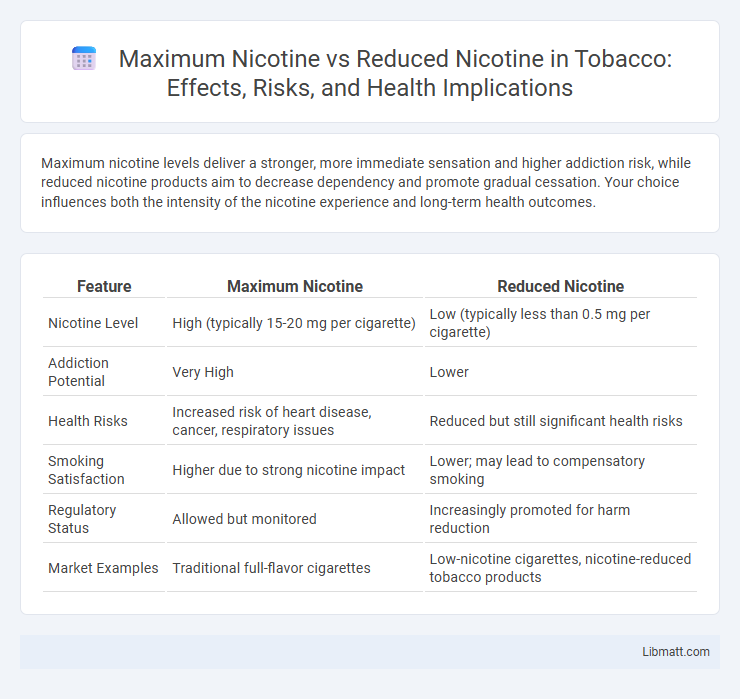Maximum nicotine levels deliver a stronger, more immediate sensation and higher addiction risk, while reduced nicotine products aim to decrease dependency and promote gradual cessation. Your choice influences both the intensity of the nicotine experience and long-term health outcomes.
Table of Comparison
| Feature | Maximum Nicotine | Reduced Nicotine |
|---|---|---|
| Nicotine Level | High (typically 15-20 mg per cigarette) | Low (typically less than 0.5 mg per cigarette) |
| Addiction Potential | Very High | Lower |
| Health Risks | Increased risk of heart disease, cancer, respiratory issues | Reduced but still significant health risks |
| Smoking Satisfaction | Higher due to strong nicotine impact | Lower; may lead to compensatory smoking |
| Regulatory Status | Allowed but monitored | Increasingly promoted for harm reduction |
| Market Examples | Traditional full-flavor cigarettes | Low-nicotine cigarettes, nicotine-reduced tobacco products |
Understanding Nicotine Levels: Maximum vs Reduced
Maximum nicotine products deliver the highest concentration of nicotine available, providing a rapid and intense nicotine hit that satisfies strong cravings and supports smokers seeking an immediate effect. Reduced nicotine products contain significantly lower nicotine levels, designed to help users gradually decrease their dependence and minimize withdrawal symptoms. Understanding the difference between maximum and reduced nicotine levels is essential for making informed decisions about addiction management and smoking cessation strategies.
Health Impacts of Maximum Nicotine
Maximum nicotine levels in cigarettes significantly increase the risk of addiction, leading to greater difficulty in quitting smoking and exacerbating long-term health issues such as heart disease and lung cancer. High nicotine intake intensifies harmful cardiovascular effects, including elevated blood pressure and increased heart rate. Understanding these risks can help you make informed decisions about nicotine consumption and prioritize your health.
Benefits of Reduced Nicotine Products
Reduced nicotine products significantly lower your risk of addiction and improve overall health by minimizing exposure to harmful chemicals typically found in high-nicotine alternatives. These products support gradual nicotine reduction, making it easier to quit smoking and reduce withdrawal symptoms. By choosing reduced nicotine options, you promote better lung function and reduce the likelihood of cardiovascular diseases linked to nicotine consumption.
Addiction Potential: High vs Low Nicotine
Maximum nicotine products deliver high levels of nicotine, significantly increasing addiction potential due to rapid dopamine release and reinforcement of dependency behaviors. Reduced nicotine products contain substantially lower nicotine concentrations, resulting in lower addiction risk by minimizing the intensity of neurochemical pathways associated with nicotine dependence. Research shows that reduced nicotine alternatives can aid in breaking habitual use patterns, facilitating cessation efforts.
Regulatory Guidelines for Nicotine Content
Regulatory guidelines for nicotine content in tobacco and vaping products vary globally, with many jurisdictions imposing strict limits to reduce health risks and addiction potential. Maximum nicotine levels are often established by regulatory bodies such as the FDA in the United States, the European Union Tobacco Products Directive (TPD), and similar agencies, setting caps typically around 20 mg/mL for e-liquids and specific limits for traditional tobacco products. Reduced nicotine regulations aim to lower nicotine concentrations to minimal levels to assist in smoking cessation and decrease dependence, supported by emerging policies encouraging manufacturers to reformulate products accordingly.
Consumer Preferences: Why Nicotine Strength Matters
Nicotine strength significantly impacts consumer preferences as many seek a balance between satisfaction and health concerns; maximum nicotine delivers a stronger hit preferred by experienced smokers, while reduced nicotine appeals to those aiming to lower dependence or transition away from smoking. Your choice of nicotine concentration influences cravings, withdrawal symptoms, and overall enjoyment, making it essential to select a level aligned with your habits and goals. Research shows that clear labeling and variety in nicotine strengths help consumers make informed decisions, enhancing user experience and adherence to harm reduction strategies.
Smoking Cessation: Role of Reduced Nicotine
Reduced nicotine cigarettes play a crucial role in smoking cessation by lowering nicotine dependence and easing withdrawal symptoms, making it easier for smokers to quit. Studies show that smokers using reduced nicotine cigarettes consume fewer cigarettes per day and have higher quit rates compared to those smoking maximum nicotine products. The gradual reduction of nicotine levels disrupts addiction patterns without compromising satisfaction, promoting long-term abstinence from tobacco.
Maximum Nicotine Products on the Market
Maximum nicotine products on the market deliver the highest concentration of nicotine available, designed to satisfy heavy smokers or those seeking intense nicotine intake. These products often include strong e-liquids, nicotine pouches, and high-nicotine cigarettes, offering rapid and potent nicotine delivery. Understanding the nicotine content in these options helps you make informed choices about consumption and manage cravings effectively.
Side Effects: Comparing Maximum and Reduced Nicotine
Maximum nicotine levels tend to increase the risk of side effects such as dizziness, nausea, and elevated heart rate due to higher nicotine absorption in the bloodstream. Reduced nicotine products typically result in milder side effects, making them a safer choice for those sensitive to nicotine or aiming to quit. Understanding these differences helps you manage your nicotine intake while minimizing adverse health impacts.
Future Trends in Nicotine Formulation
Future trends in nicotine formulation emphasize the shift from maximum nicotine concentrations, typically exceeding 20 mg/mL in traditional e-liquids, to reduced nicotine products aimed at minimizing addiction and health risks. Innovations include nicotine salts and synthetic nicotine, enabling smoother delivery at lower doses while maintaining user satisfaction. Regulatory pressures and consumer demand drive the development of customizable nicotine strengths and harm reduction-focused alternatives.
Maximum nicotine vs reduced nicotine Infographic

 libmatt.com
libmatt.com